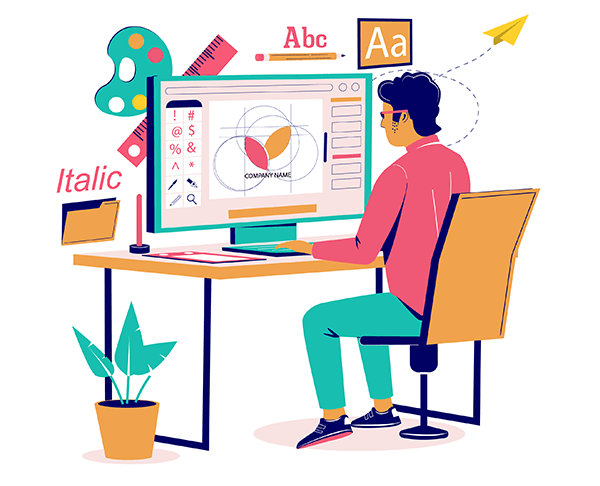What is Graphic Design?
Graphic Design is the art and practice of creating visual content to communicate messages. It involves combining text, images, illustrations, and other visual elements to produce designs for both print and digital media. Graphic design is used in various fields such as advertising, branding, marketing, web design, and user interfaces.
Graphic design is a powerful way to convey a message visually, create a visual identity for brands, or present information in a way that is easy to understand and aesthetically appealing.

Key Areas of Graphic Design
Graphic design spans several disciplines, each with its own set of principles and tools. Here are some key areas:
- Branding and Logo Design:
- Creating a unique visual identity for a brand.
- Logo design is a major part of branding, with an emphasis on creating simple yet memorable symbols that represent the brand’s values and mission.
- Advertising and Marketing Design:
- Creating promotional materials such as flyers, posters, brochures, and digital ads.
- Focuses on creating designs that engage customers, convey a message clearly, and encourage action (like making a purchase).
- Web and User Interface (UI) Design:
- Designing the visual layout of websites, apps, and other digital platforms.
- Focuses on creating an intuitive, user-friendly interface that enhances the user experience (UX).
- Print Design:
- Involves creating physical designs for print materials such as business cards, billboards, packaging, magazines, books, and more.
- Focuses on working with colors, typography, and imagery in a way that translates well to printed materials.
- Motion Graphics:
- Creating moving visuals, often combined with sound, for media such as video, animations, and television.
- Used in movies, commercials, explainer videos, and web animations.
- Infographic Design:
- Creating visual representations of information or data.
- Infographics help explain complex information quickly and clearly by using charts, diagrams, and other visual aids.
- Editorial Design:
- Designing layouts for magazines, books, newspapers, and other publications.
- This area of graphic design focuses on typography, page composition, and layout for readability and visual appeal.
- Packaging Design:
- Designing packaging for products that not only protects the item but also attracts customers and communicates the brand’s identity.

Elements of Graphic Design
Graphic design relies on several fundamental elements to create an effective composition. These elements are the building blocks of every design:
- Line:
- A line is the most basic element of design, which can be used to divide spaces, create shapes, or guide the viewer’s eye.
- Lines can be straight, curved, thick, thin, or broken, and they play a role in adding structure to a design.
- Shape:
- Shapes are flat, enclosed areas created by lines or the filling of an area with color or texture. Common shapes include squares, circles, triangles, and organic forms.
- Shapes can create emphasis, convey messages, or evoke emotions in a design.
- Color:
- Color is one of the most powerful elements of design. It conveys emotions, creates visual harmony, and draws attention to certain elements of the design.
- Colors can be classified as primary, secondary, and tertiary, and color theory helps guide designers in choosing complementary and contrasting colors.
- Texture:
- Texture refers to the surface quality of a design, which can either be actual (real textures in physical objects) or visual (textures that appear in the design).
- Texture adds depth, interest, and richness to a design.
- Space:
- Space refers to the area around and between elements in a design. It can be positive (filled with elements) or negative (empty space).
- Proper use of space is crucial in creating balance, emphasizing elements, and improving readability.
- Typography:
- Typography is the art of arranging type to make written language readable, legible, and visually appealing.
- The choice of fonts, letter spacing (kerning), and line spacing (leading) all affect the readability and mood of a design.
- Form:
- Form refers to the three-dimensional quality of an object or design. While shapes are flat (2D), forms have depth, creating a more lifelike or realistic design.
